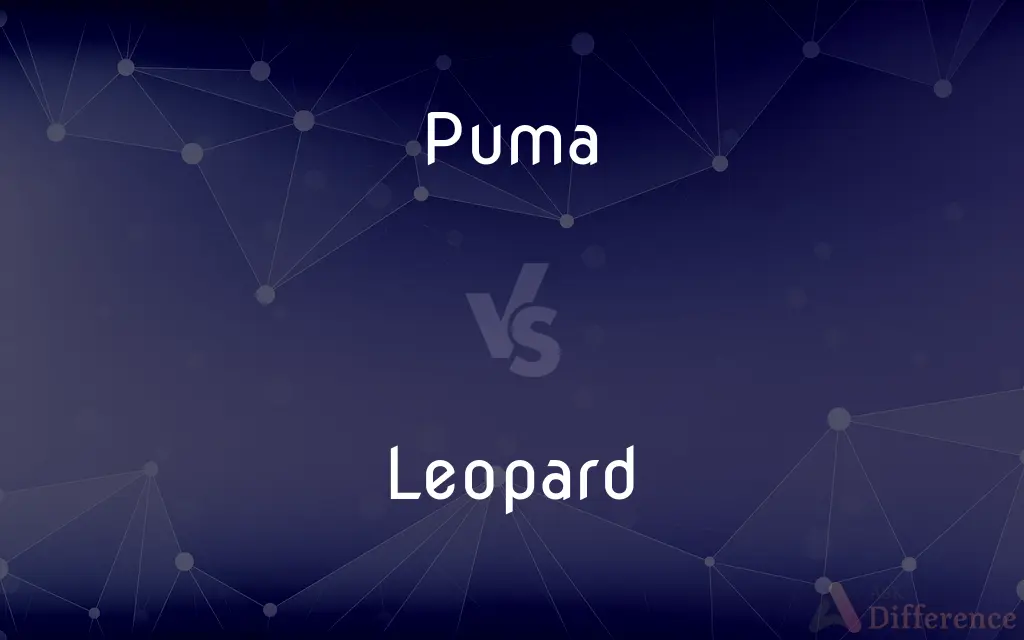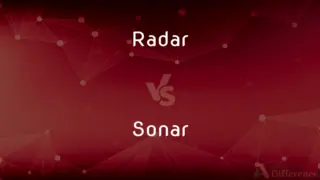Puma vs. Leopard — What's the Difference?
By Tayyaba Rehman — Updated on October 13, 2023
Puma and leopard are distinct wild cats, the former, native to the Americas, is large, slim, and lacks rosettes, while the latter, found in Africa and parts of Asia, is known for its spotted coat and robust build.

Difference Between Puma and Leopard
Table of Contents
ADVERTISEMENT
Key Differences
Pumas, scientifically known as Puma concolor, inhabit various regions across the Americas. In contrast, leopards (Panthera pardus) are distributed across some parts of Africa and Asia, reflecting disparate geographical habitats between the two species. Pumas are adapted to a range of environments, from forests to deserts, while leopards have developed the agility to move both on the ground and in trees with ease.
Leopards are well-known for their distinctive rosette-patterned coats and significantly robust, muscular bodies. Pumas, however, do not possess the notable spots; instead, they exhibit a more uniform coat color, generally tan or reddish-brown, and have a more slender build. The visual distinction between the two animals is thus quite noticeable, particularly regarding their coat patterns and overall physique.
When evaluating their physical characteristics, the puma, often referred to as a mountain lion or cougar, typically has a smaller head and a notably long, cylindrical tail. The leopard, on the other hand, displays a broader, more powerfully built head and a shorter tail, which often features a distinctive, white tip underneath that assists with camouflage and communication among species.
Pumas are well-known for their incredible leaping ability and strength, capable of executing exceptional vertical leaps, especially when hunting. Conversely, leopards exhibit notable climbing prowess, often hauling their prey into trees to avoid scavengers and to consume at their leisure. These respective physical capabilities highlight their adaption to their specific environments and hunting needs.
Despite being solitary animals, both the puma and leopard have been observed to exhibit territorial behaviors. Pumas utilize vocalizations, scrapings, and scent markings to establish their domain, while leopards similarly use scent marking and vocalizing to communicate with potential rivals and mates, ensuring a clear establishment of their territorial boundaries.
ADVERTISEMENT
Comparison Chart
Geographical Habitat
Found in the Americas
Found in Africa and parts of Asia
Physical Appearance
Uniform coat, no rosettes, slender build
Rosetted coat, robust build
Head and Tail
Smaller head, long cylindrical tail
Broader head, shorter tail with a white tip
Climbing Ability
Exceptional leapers, less adept climbers
Excellent climbers, often store prey in trees
Scientific Name
Puma concolor
Panthera pardus
Compare with Definitions
Puma
A solitary and territorial animal.
The puma marked its territory with strategic scrapings on the tree bark.
Leopard
A large cat species distinguished by its rosetted coat.
The leopard’s spotted coat aids it in blending into its surroundings.
Puma
Noted for their impressive leaping ability.
With a powerful leap, the puma caught its prey off guard.
Leopard
Exhibits a muscular build with a relatively short tail.
The leopard’s muscular build facilitates its ability to haul prey into trees.
Puma
A large, tawny cat native to the Americas.
The puma can be found in various environments, from deserts to forests.
Leopard
Known for hauling its prey into trees.
The leopard dragged its catch up the tree to enjoy its meal undisturbed.
Puma
Possessing a uniform coat color without rosettes.
The puma’s uniform tan coat helps it blend into its arid surroundings.
Leopard
A solitary predator with territorial instincts.
The male leopard used scent markings to demarcate its territory.
Puma
Also known as a mountain lion or cougar.
The puma, or mountain lion, is admired for its graceful yet powerful build.
Leopard
Predominantly found in Africa and parts of Asia.
In Asia, spotting a leopard in the wild is considered a rare sight.
Puma
A German multinational corporation that designs and manufactures athletic and casual footwear, apparel and accessories
Leopard
The leopard (Panthera pardus) is one of the five extant species in the genus Panthera, a member of the cat family, Felidae. It occurs in a wide range in sub-Saharan Africa, in some parts of Western and Central Asia, Southern Russia, and on the Indian subcontinent to Southeast and East Asia.
Puma
A large American wild cat with a plain tawny to greyish coat, found from Canada to Patagonia.
Leopard
A large wild cat (Panthera pardus) of Africa and southern Asia, having either tawny fur with dark rosettelike markings or black fur.
Puma
See cougar.
Leopard
Any of several similar felines, such as the cheetah or the snow leopard.
Puma
A mountain lion or cougar (Puma concolor).
Leopard
(Heraldry) A lion in side view, having one forepaw raised and the head facing the observer.
Puma
(by extension) Any feline belonging to the genus Puma.
Leopard
Panthera pardus, a large wild cat with a spotted coat native to Africa and Asia, especially the male of the species (in contrast to leopardess).
Puma
(slang) A woman in her 20s or 30s who seeks relationships with younger men; a younger cougar.
Leopard
(inexact) A similar-looking, large wild cat named after the leopard.
Puma
A large American carnivore (Felis concolor), found from Canada to Patagonia, especially among the mountains. Its color is tawny, or brownish yellow, without spots or stripes. Called also catamount, cougar, American lion, mountain lion, and panther or painter.
Leopard
The clouded leopard (Neofelis nebulosa), a large wild cat native to Asia.
Puma
Large American feline resembling a lion
Leopard
The snow leopard (Panthera uncia), a large wild cat native to Asia.
Leopard
(heraldry) A lion passant guardant.
Leopard
Any of various nymphalid butterflies of the genus Phalanta, having black markings on an orange base.
Leopard
A large, savage, carnivorous mammal (Felis leopardus). It is of a yellow or fawn color, with rings or roselike clusters of black spots along the back and sides. It is found in Southern Asia and Africa. By some the panther (Felis pardus) is regarded as a variety of leopard.
Leopard
The pelt of a leopard
Leopard
Large feline of African and Asian forests usually having a tawny coat with black spots
Common Curiosities
Do pumas have a rosetted coat like leopards?
No, pumas have a uniform coat without the rosettes found on leopards.
What other names are pumas known by?
Pumas are also referred to as cougars, mountain lions, and panthers.
Are leopards found in the Americas?
No, leopards are native to Africa and some parts of Asia.
What is the general color of a puma’s coat?
Pumas generally have a tan or reddish-brown uniform coat color.
Are leopards larger than pumas?
Pumas and leopards are quite similar in size, but leopards tend to be more robust and muscular.
Where can pumas be found in the wild?
Pumas inhabit various regions across the Americas.
Are leopards skilled climbers?
Yes, leopards are adept climbers and often store prey in trees.
How do leopards communicate or mark territory?
Leopards use vocalizations and scent markings to communicate and establish territory.
Is the leopard part of the Panthera genus?
Yes, the scientific name of the leopard is Panthera pardus.
What is the scientific name of the puma?
The scientific name of the puma is Puma concolor.
What is a notable physical characteristic of leopards?
Leopards have a robust, muscular build with a distinctly patterned coat.
Can pumas climb trees as leopards do?
While pumas can climb, they are not as adept at tree climbing as leopards.
How does the puma’s tail differ from the leopard’s?
The puma has a longer, cylindrical tail, whereas the leopard’s is shorter with a white-tipped underside.
Do leopards live in desert environments like pumas?
Leopards can adapt to various environments, including grasslands, forests, and even semi-arid regions, but not typically deserts like pumas.
Share Your Discovery

Previous Comparison
Radar vs. Sonar
Next Comparison
Aeon vs. EonAuthor Spotlight
Written by
Tayyaba RehmanTayyaba Rehman is a distinguished writer, currently serving as a primary contributor to askdifference.com. As a researcher in semantics and etymology, Tayyaba's passion for the complexity of languages and their distinctions has found a perfect home on the platform. Tayyaba delves into the intricacies of language, distinguishing between commonly confused words and phrases, thereby providing clarity for readers worldwide.














































